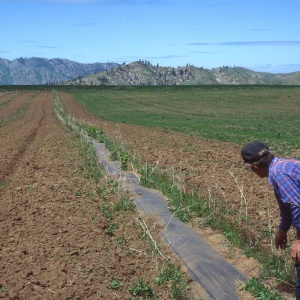
This paper assesses the rate of soil erosion in different countries, aiming to separate the effect of varying landscapes from the effect of different national territories, e.g. through different agricultural policies or management patterns. As an example of a sharp discontinuity in soil erosion between neighbouring countries, visible on satellite images, the paper shows the difference between Haiti (with a high soil erosion rate) and the Dominican Republic (with greater forest cover and a lower soil erosion rate) - two countries that would have similar natural soil erosion rates in the absence of human activity.
The paper compares modelled natural soil erosion rates with actual soil erosion rates. Across about 40% of borders, the authors say, political borders do match with environmental borders in that there is a significant discontinuity in the natural rate of soil erosion. However, across most borders, the difference in soil erosion can be attributed to being in a different country as opposed to being in a different type of natural environment.
The paper finds that country-specific erosion rates are most highly correlated with differences in agricultural patterns, such as agricultural intensity (greater intensity, measured by fertiliser use per hectare, is associated with lower soil erosion) and the share of GDP and employment attributed to agriculture (in both cases, the more important agriculture is, the more soil erosion there is).
The figure below shows how soil erosion rates are affected by countries across the world. Darker green indicates that a country is associated with lower soil erosion rates than its neighbours, while darker red indicates that a country is associated with higher soil erosion rates than its neighbours. Note that this does not necessarily mean the countries in darkest red have the highest absolute soil erosion rate, since natural erosion rates vary across the world.
 Image: Figure 3, Wuepper et al. The map is based on soil erosion discontinuities between each country and all of its neighbours (unweighted). For all countries that perform more poorly than their neighbours, the map shows how much soil erosion they could mitigate (per hectare and year) just by catching up to their neighbours. For reference, the global average soil erosion rate is 2.4 t ha−1 yr−1.
Image: Figure 3, Wuepper et al. The map is based on soil erosion discontinuities between each country and all of its neighbours (unweighted). For all countries that perform more poorly than their neighbours, the map shows how much soil erosion they could mitigate (per hectare and year) just by catching up to their neighbours. For reference, the global average soil erosion rate is 2.4 t ha−1 yr−1.
Abstract
Soil erosion is a major threat to food security and ecosystem viability, as current rates are orders of magnitude higher than natural soil formation. Governments around the world are trying to address the issue of soil erosion. However, we do not know whether countries have much actual control over their soil erosion. Here, we use a high-resolution, global dataset with over 35 million observations and a spatial regression discontinuity design to identify how much of the global rate of soil erosion is actually affected by countries and which country characteristics, including their policies, are associated with this. Overall, moving just across the border from one country to the next, the rate of soil erosion changes on average by ~1.4 t ha−1 yr−1, which reveals a surprisingly large country effect. The best explanation we find is countries’ agricultural characteristics.
Reference
Wuepper, D., Borrelli, P. and Finger, R., 2019. Countries and the global rate of soil erosion. Nature Sustainability, pp.1-5.
Read the full paper here. See also the Foodsource resource How do food systems affect land-use and biodiversity?












Post a new comment »